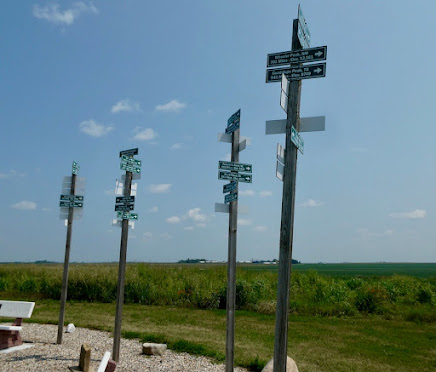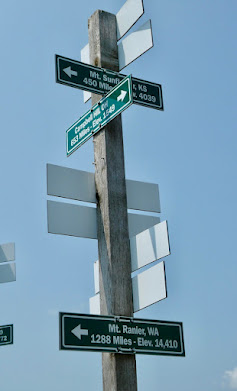Two days with one major visit each day with biking - South Dakota High Point with Sioux Falls, SD and the State Capital in Pierre, SD.
Our first sight after leaving Des Moines was Hawkeye Point, the 1,670 foot, high point for Iowa. It is in the Northwest corner of the state surrounded by rolling country with corn and soybean fields in all directions. It is less than 5 miles from Minnesota. The site used to be part of a private farm, but the owners gave it to the state in 2009.
Overview of Hawkeye Point.
One neat display is these four posts with the 50 highpoints shown on each sign, with an arrow pointing roughly in the right direction. The signposts make that point that NW Iowa is slightly closer to the east coast than the west coast. Even though we have turned the corner on this trip and are heading home, we still have a long way to travel.
Note, the sign for Mt Hood, OR and the direction and distance
I am not sure you can tell, but Mt. Rainier is pointing in the same direction as the Kansas highpoint, and not toward the west. Maybe the person that hung it was thinking of Washington, DC.
Native Prairie plants
We can finally put a name to the decorative panels on barns -- Barn Quilts
An early John Deere implement, which does not "run." This is part of an antique farm equipment display at the high point.
Another mechanical John Deere.
Cornfield
From the high point, we drove a short way, crossing the border into South Dakota and stopping for the night in Sioux Falls. They have a great 26-mile loop bike trail which we did about half, before cutting across town back to the hotel. We passed a number of parks and sports fields, following the Big Sioux River. We passed the zoo for the bison photo below.
Part of the trail was on a levee which protects the city.
Our hotel - a much better location than the previous night.
Today, we were off to Pierre, SD but, before leaving Sioux Falls, we went to visit the Falls. It is rather impressive set of cascades. The Big Sioux River flows over quartzite, which is a hard rock. Quartzite is harder than granite and nearly as hard as diamond (at least, that is what the sign said). Sounds like it would be great for construction, but its hardness makes it hard to cut. Like elsewhere in the country, development occurred at the Falls very early in the city's history.
The penstock (pipe) supports leading to the powerhouse for the Queen Bee Mill. The powerhouse is in the distance. I am standing where the Gate House was.
The Mill would grind grain and corn very efficiently but went bankrupt within few years.
The powerhouse, though all it did was redirect the power from a vertical shaft to a horizontal shaft.
The overview of the entire Falls.
A train passing from right to left.
I believe the Corn Palace, which is largely covered with various colored corn cobs, is redecorated each year with a different theme. This is last year's decoration with the theme "Under the Big Top."
Circus scenes in each panel - again this is corn cobs, used like mosaic tiles.
We drove the rest of the way to Pierre (pronounced "peer"). We checked in to our motel and then rode about a mile to the State Capital building, which dates to 1910 and is modeled on the Minnesota capital. It is a smaller building than the previous Capitals we have seen, but classy in its own way. There was no guided tour, only a self-guided one. We wandered around and enjoyed yet another visit to a State Capital.
This is a piece of terrazzo flooring which was laid by 63 Italians. Each worker was allowed to place one blue tile in the floor. This is an example. The guide said that only 57 have actually been found. Its size is about 1/2 inch square.
Only one dome - looking up.
The Grand Staircase.
An example of one of the many lunettes in the hallways depicting scenes from early in South Dakota statehood.
A swallow that is usually difficult to photograph, since they are continuously flying and swooping. This was taken through a window in the Capital.
The Senate Chamber - 35 seats - with roll-top desks.
The House Chamber - 70 seats.
One of the many stenciled decorations covering the ceilings and upper walls.
The summary for visitors
The WWII Memorial at Capital Lake, which is fed by an artesian spring with warm water. The lake never freezes.
The spring gushing up.
We saw some large fish, unknown type, and this little guy in the Capital Lake.
The Capital across Capital Lake.






































I’ve been to the corn palace. The theme was some kind of music that year. There was a good mural of Elvis. What a fun trip you are having. Thanks for sharing. Cg
ReplyDeleteGreat photos and history lessons once again! Love the swallow photo too... had no idea they were so colorful!
ReplyDeleteLove the Corn Palace. Brings back fond memories. Next stop ... Wall Drug?
ReplyDelete